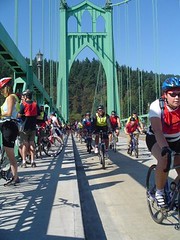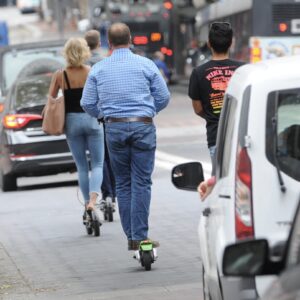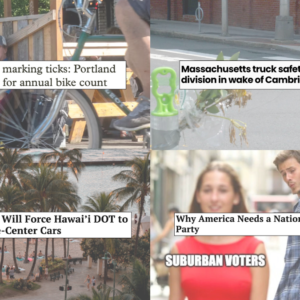I just received the final bridge bike traffic counts.
Overall, the average daily number of bicyclists that ride across our four main downtown bridges (Steel, Broadway, Burnside, Hawthorne) was up 18% in 2006.
PDOT also has non-bridge bike traffic counts from about 20 or so other key locations throughout the city. They haven’t yet organized all the findings and I hope to have a more complete report soon, but my source at the City has shared several little nuggets.
First, here’s the final bridge breakdown:
Steel
- 2005: 2,112
- 2006: 2,373
- 12% increase
Broadway:
- 2005: 2,081
- 2006: 2,856
- 37% increase
Burnside:
- 2005: 1,170
- 2006: 1,260
- 8% increase
Hawthorne:
- 2005: 4,829
- 2006: 5,557
- 15% increase
Overall for four bridges:
- 2005:10,192
- 2006: 12,046
- 18% increase
And here are a few factoids from the non-bridge locations:
- N Vancouver & Russell: 215 cyclists in 2003 to 380 cyclists in ’06 from 7 to 9AM (an 78% increase)
- NE Weidler & 7th: 131 cyclists in ’04 to 241 cyclists in ’06, from 4 to 6PM (an 84% increase)
- SE Ladd Circle: 327 cyclists in ’04 to 470 in ’06, from 4-6PM (a 44% increase)
Very exciting numbers! Stay tuned for more as the counts are analyzed and digested by the cycling statisticians over at PDOT. We should be seeing some cool charts and graphs as they overlay bike traffic with crash data and other stats.







Thanks for reading.
BikePortland has served this community with independent community journalism since 2005. We rely on subscriptions from readers like you to survive. Your financial support is vital in keeping this valuable resource alive and well.
Please subscribe today to strengthen and expand our work.
It would be interesting to see similar stats on car traffic at the same points. I’d like to see if car trips have down over this time period or if trips in general have gone up.
What about the sellwood bridge? Or do they not want to think that bikes use that so they can continue ignoring it rather actually have to do someting about it.
Lower the speed limit (it’s not like cars in rush hour can do the speed limit anyways) and add a lot more signage that one measly “bikes in roadway” sign.
/bridge rant
errrr, what do these numbers mean? Were there 327 cyclists in ladds all year, just one day, or how do they conduct the surveys?
I’m wondering why the non bridge surveys points are so much higher? Is biking way more popular, but going across the river is sooo last year?
Dan Porter,
I’m not so sure if you compared the increase in cyclist vs the increase or decrease in vehicles is a fair comparison to see which is becoming more popular. Reason being…EVERY sixteen year old year after year will get a drivers license regardless if they pedal or not. Its also a fact that more people get a licesnce vs loose a license each year.
I guess I could be way off in my thinking but due to the above I don’t think you can really compare.
gabrielamadeus,
The bridge numbers are based on “average daily number of bicyclists”. The other locations are daily numbers within the timeframes given.
“I’m wondering why the non bridge surveys points are so much higher?” Are you referring to the percentage increases being higher? It’s easier to raise percentages when the counts are lower. 100 to 200 is a huge percentage increase. 2,000 to 2,100 is a small percentage increase even though the increase in number of bicyclists is the same.
oh yeah. That makes sense now, thanks for clarifying!
For my money, the Burnside Bridge should have a lot more riders…its got a great view (no superstructure) and connects directly with the street grid on both sides of the river.
Maybe the problem is bikelanes that put you right next to traffic on a high speed roadway as opposed to an above the curb facility.
For some reason, this bridge has three traffic lanes in one direction and two in the other…feeding into an arterial that is basically four lanes (2 each way).
Why not take that extra auto lane and the bike lanes and create really wide promenade-like sidewalks on both sides for bikes and peds. There would even be room for benches in spots and a coffee vendor cart.
Take my word for it, from the middle of the bridge you have the best view of Portland. This is an asset we are not using to the fullest.
I love that 12,000 people ride into downtown every day! That is amazing! It makes me proud to live in such a bike friendly town. I imagine numbers like this will only lead to more bike commuters… if 12,000 people can do it why can’t you? Anything is better than being stuck in traffic. ugh.
Before we get all excited, I’m still interested in the methodology of the study. I can’t believe PDOT employees are out there every day counting bikes, so how many days did they count bikes for each bridge and for the other intersections? And at what time of year? And if they counted all year round, is there a breakdown for summer, fall, winter and spring.
Burnside Bridge is my favorite, too, mostly because it’s so central to everything. Counts may be lower because of all the work on the bridge this year.
dom, people die everyday and usually stop driving long before then — the increase in bike riders apparently exceed the Oregon and/or Portland growth rates. I’m not saying there is a decrease of motor vehicles, but the numbers are skewed lower as a result of more bicylists exceeding the growth rate.
Portland is indeed an interesting case study. For the last 80 years, road and freeway engineers have operated under the old adage “if you build it, they will come”. Therefore, money spent on freeway construction was justified because it was used (regardless of how inefficient and costly it was). Portland can point to their expansion of the official bike route network as one of the reasons for the increase in ridership, and thus justify additional investment in this type of infrastructure. This flies in the face of most communities in the country where the traffic engineers scoff at the thought of providing bike lanes or other bike infrastructure in a community where “no one” bikes. I hope that someday, Portland can convince the rest of the nation that biking is a legitimate form of transportation.
Don’t forget there are thousands of additional bicyclists pedaling in from NW, and all of the future residents of South Waterfront who will be pedaling in along the to-be built waterfront park extension.